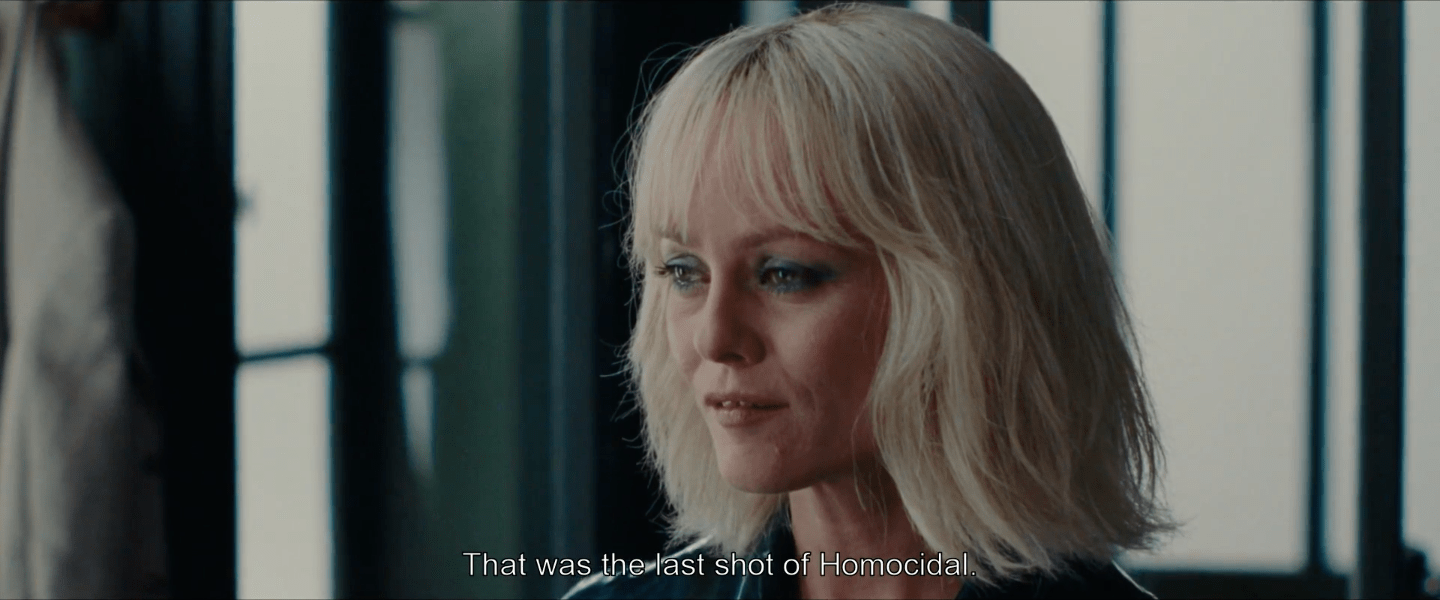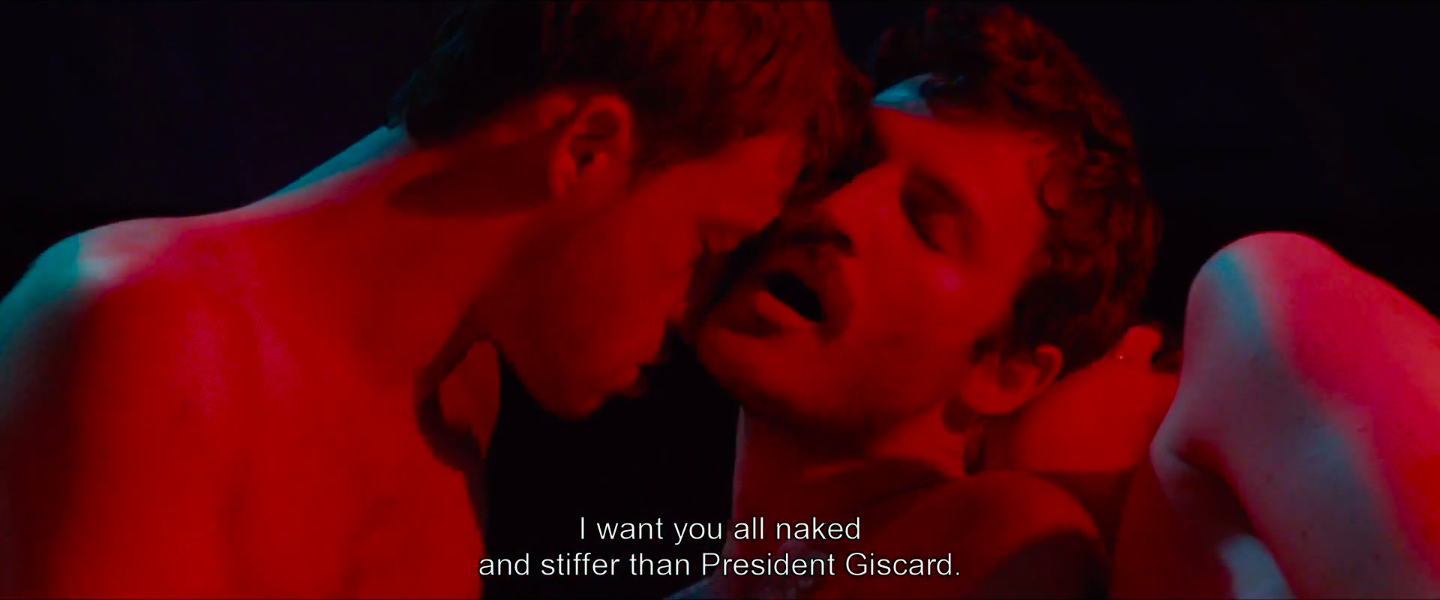A young couple are making out in the middle of a forest, tearing at each other’s clothes in a moment of unbridled passion and sexual discovery. But unknown to the two of them, they’re also being watched, with an older man dressed in black leather licking his lips at the teenage lust in front of him. If it sounds like the beginnings of a horror movie, then you’d be right. If it sounds like the beginnings of a low-budget porno, then you’d… also be right.
As depicted in the opening scene of Knife + Heart, a gloriously stylish ode to disco, queer sex and 1970s giallo, the moment lays down the film’s unique artistic stance: that the separation between pornography and the slasher movie is thin, both genres as equally eager to worship their stars as they are eager to degrade them, regularly sharing of the same faces (X-rated icons including Traci Lords, Jenna Jameson and Sasha Grey all went “legit” in their own horror vehicles), while goading audiences to respond in similar ways. In both porn and horror, characters are less people than they are archetypes, tension building to satisfy a primal urge, with rhythmic, agonizing suspense carefully teased out until the delivery of that final money shot.
“I think I was as fascinated by porn as I was fascinated by horror when I was a teenager,” director Yann Gonzalez tells i-D during a sit down at the London Film Festival. “They both deal with excess or transgression. They were images I was not allowed to look at, so my only goal as a teenager was to look at them. And, remember, there was no internet at that time, so it [involved] like stealing porn magazines from the bookstore, or finding the hidden VHS belonging to my parents. It was like a quest for me, fueled by guts, by my obsessions, my fantasies. Knife + Heart, for me, tries to recall those feelings, and looking for those forbidden images.”
Set in the Paris of 1979, in an age of porno cinemas, pubic hair, and twinks in tube-socks, Knife + Heart stars Vanessa Paradis as Anne, a pornographer outfitted in Debbie Harry cosplay, with bottle-blonde hair, black roots and a succession of sheer blouses. As predatory as she compassionate, Anne gets off on skirting the edges of illegality, from baiting local police to driving through the country and picking up the scent of pretty, aimless young men, cornering them with promises of sex, money and glamour. The one catch, she purrs — “We’re short on girls, so it’s boys on boys.”
She is also losing her mind, driven to emotional ruin by her recent split from the sophisticated Lois (Kate Moran), who also happens to edit her films. And when a serial killer armed with a knife hidden inside of a dildo begins murdering her actors, Anne’s response worries her regular crew. Instead of shutting production down, she begins to incorporate the crimes into her work, real-life horror inspiring her to begin shooting a pornographic slasher movie she cutely titles Homocidal.
Knife + Heart celebrates two forms of entertainment that possess seemingly obvious connections, but it’s a dynamic that mainstream horror cinema is typically reluctant to explore. Brian De Palma, who Gonzalez describes as his “idol”, is one of the few to have dabbled in it, with his cult 1984 thriller Body Double set within the seedy underbelly of LA’s porn scene and digging into the darkest corners of sexual obsession. But other entries in this particular sub-genre are harder to find, safe for Ron Jeremy’s horror spoof One-Eyed Monster, or the grungy Nicolas Cage thriller 8MM.

They’re also movies that tend to fixate on the idea of pornography as a place of unrelenting misery; scuzzy enterprises full of addicts, weirdos and exploitation. Knife + Heart takes a different stance, largely inspired by the inherent silliness of French gay pornography. The dialogue and acting in Homocidal is as ludicrously heightened as its numerous on-screen ejaculations, which have all the firepower of an exploding can of whipped cream. Gonzalez suggests that American porn is dominated, more often than not, by rage and degradation, something that modern French pornographers have grown to emulate, but that their predecessors avoided.
“French porn was super silly,” he says. “They were dubbed with stupid voices most of the time, and I really wanted to translate the silliness of those films. There were some gems, and some that were really beautiful, but those were the exceptions. Most were not made for the beauty or the art, but made for jerking off. And they didn’t care. They were shooting one film in one afternoon, and sometimes the film was released in porno cinemas maybe two weeks after. Everything was made at such speed in such silly spirit, and that’s what made those films so fresh and entertaining.”

That same spirit is mirrored in the film’s sprawling ensemble of porn stars, artists, fluffers and drag queens, a cast of characters reflective of how often both horror cinema and pornography are dominated by cultural outsiders, and individuals generally overlooked by the mainstream. Gonzalez speculates that 98% of his film’s characters are queer, but in a further upending of traditional genre tropes, here they are not secondary victims, but instead fully fleshed out, humanized and heroic.
He adds that the utopian, sexually-uninhibited joy of many of Knife + Heart’s characters was intentional, reflecting an era of sexual freedom that was tragically torn down by AIDS — a crisis that would hit Paris a year after the events in the film.
“I wanted [queerness] to be depicted in a very peaceful and natural way,” Gonzalez says. “It was not something where I wanted to shock the straight audience of the film. On the contrary, I wanted to invite straight audiences to be part of this territory, of this queer haven. It’s not a complete haven, because it’s dark at the same time, but the best compliment I can have from the audience is when people say to me that they want to live in my film. Because those are the films that I love the most.

He continues, “When I was a teenager I wanted to live in Gregg Araki’s Nowhere. I was 20 years old when it was released and I watched it like maybe seven or eight times at the cinema, I was so obsessed with that film. So to me when I’m making a film I want to create a world that is desirable, and this is what I tried to do with my queer characters. I wanted them to be lovable and full of life and inviting.”
Knife + Heart builds to a climax that feels in keeping with its horror lineage — there’s a woman in peril, a masked killer in pursuit and a last-minute twist. The scene also occurs in a porno theater, our leading lady sprinting through the aisles in terror, surrounded by men in the midst of getting off. It should be a jarring juxtaposition, an unexpected melding of two vastly different worlds. But with those men in the shadows, the exposure of our basest instincts and the shock reveal of various bodily fluids, it’s hard to see where the sex ends and the death begins.
Knife + Heart is due to be released in the US early next year.
